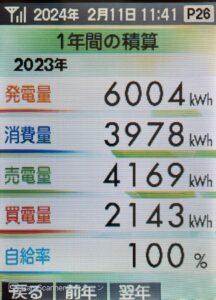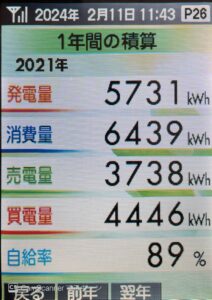2024.02.11
Since the latter half of last year, inquiries about job offers and job seeking have been increasing, and at the same time, the number of applications for cooperation from both domestic and overseas companies has been surging. My intuition tells me that while the human resources market is booming, mismatches are increasing and the response of agents is shifting from monopoly to collaboration. This is why I am a little behind in updating this blog. I am thankful for the consecutive holidays, which are like an oasis at times like this.
This time, the theme is a summary of last year's energy conservation efforts. The factors are the energy-saving effects of solar power generation, BEVs, and V2H. Below are the specs for each device.
Photovoltaic power generation 4.14kw made by former Sanyo, introduced in 2011 (purchase initially F10 years fixed 42 yen, expires 2021, now 13.8 yen)
BEV Nissan LEAF e+ 62kw purchased in 2017 (ZESP3)
V2H Made by Nichicon Introduced in 2022
The Great East Japan Earthquake triggered a sense of energy crisis that inspired me to start generating my own electricity, but I have since added my interest in environmental issues and new technologies to the mix. It sounds good to say that he is the first penguin, but he is probably seen by those around him as an eccentric and a spendthrift. In 2011, solar panels were expensive, but the subsidies and FITs (Feed-in-Tariffs) were generous enough to compensate for the high cost of the panels. The amortization period is based on the 8 years proposed by the installer. The actual amortization period was less than seven years, compared to the eight years proposed by the equipment supplier. The reason for this was that the solar efficiency was better than that of a standard location. The equipment supplier's proposal, including quotations, was sincere. This is how we look back.
The BEV was a replacement for a gasoline-powered car, but it was a very impulse purchase. The inventory car (not a new used car) was sold at a very low price. The fact is that the reputation of BEVs was questionable to a far greater degree than it is today, and the sales target was limited. So perhaps they were targeted. If the customer owns another gasoline-powered vehicle, lives in a single-family home, and has fast-charging facilities nearby, the number of target households is not so large. I was skeptical about the future infrastructure of recharging facilities and services, but the no emissions, light and quiet driving feel, toy-box-like driver's seat, and unlimited quick-charging plan were appealing enough for me to purchase the car. Although the car has some disadvantages, such as slow charging when going on long trips, the need to be careful when selecting routes, and poor resale value, we are highly satisfied with the car. However, we are very satisfied with the car, because it is also a storage battery and will continue to be useful in the future. They are not only used for transportation. We think of it as a storage battery unit with a computer and tires.
The last installation was V2H, a decision based on the prospect of a power outage crisis due to a major earthquake in the near future, and even if that does not happen, the recent climate warming and energy supply problems will make electricity prices inevitable. Fortunately, we did not have to make any changes to the house or the electric system, and it turned out to be a reasonable investment.
The first part of this article is long, but before going into the main topic, I would like to say a few words. I would like to add that there were no costs incurred after the purchase and installation. All three of these facilities have been trouble-free up to now. This may be due to our good fortune in finding individual units, but it also seems to be a result of the belief that each company has put its company's fortunes on the line to lead the world in the development and marketing of these products.
2021 vs. 2023


After the introduction of V2H, the self-sufficiency rate reached 100% (151% in FY2023) and has been maintained so far. However, there are cases in which the electricity is currently recharged outside the home and supplied to the home, and since a revision of the recharging service menu is inevitable in the future, the return on investment is expected to decrease. In the next issue, we will compare and discuss "all solar," "solar only," "solar + BEV," and "solar + BEV + V2H," using historical data as well.